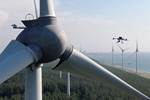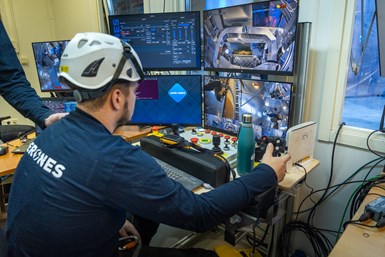Aerones unveils modular robot for Level 1-3 wind turbine maintenance, repair
Resilient, full-service system can perform a variety of tasks five times faster and more safely than human technicians, while proactively addressing extreme erosion progression.
Share
Read Next
The modular Aerones robotic system for wind blade maintenance and repair. Photo Credit, all images: Aerones
Aerones (Riga, Latvia) has unveiled and demonstrated a robot that offers full-service leading edge wind turbine blade maintenance and repair. The robot is said to perform maintenance five times faster than humans, and makes use of various attachments to perform different tasks, including refinishing blades with Relest coatings from AkzoNobel (Amsterdam, Netherlands). The robot is able to perform maintenance and repair for Level 1-3 leading edge erosion (LEE), proactively addressing erosion in a cost-effective manner and halting progression to Level 4-5 erosion.
Through the robotized system, Aerones is able to eliminate the need for rope access technicians — a profession that is considered potentially hazardous — thus increasing the safety of maintenance technicians while performing repairs faster, reducing downtime and costs. For example, the robot is able to work in conditions of wind up to 15 km/s, while technicians are only able to work in conditions of up to 9 km/s.
The modular system is able to perform multiple tasks including wind turbine blade surface cleaning; surface preparation; leading edge protective tape removal; primer application; leading edge filler application; and leading edge protection coating. In the future, the company will be adding leading edge crack repair functionalities to the system’s repertoire.
“We continue to work towards making the robot as resilient as possible to various external conditions, which is why we’ve tested our system in extreme heat, humidity and wind,” says Danis Kuze, co-founder of Aerones. “Our ultimate goal is to create a product where wind turbines would only have to be stopped for a short time, or not at all, in order to be repaired.”
Aerones has also implemented smart wind turbine modeling and erosion progression modeling by making use of digital twin technology. The system is able to replicate the wind turbine in a digital environment for monitoring and modeling for data-based decision making.
The Aerones system is used by 30 teams servicing thousands of wind turbines around the world. It has been used in North America, South America, Europe and will soon be traveling to Australia.
Related Content
-
Composites end markets: Automotive (2024)
Recent trends in automotive composites include new materials and developments for battery electric vehicles, hydrogen fuel cell technologies, and recycled and bio-based materials.
-
Composites end markets: Energy (2024)
Composites are used widely in oil/gas, wind and other renewable energy applications. Despite market challenges, growth potential and innovation for composites continue.
-
ECOHYDRO project to enable recyclable composites for hydrogen storage
With the involvement of two schools from the Institut Mines-Télécom, the 4-year project aims to improve the intrinsic properties of a composite material based on Elium via four concrete demonstrators.

















